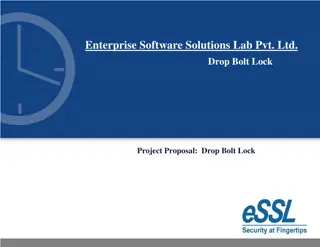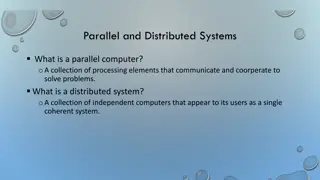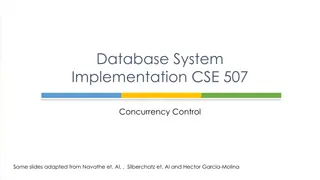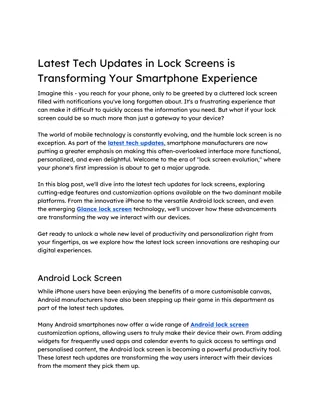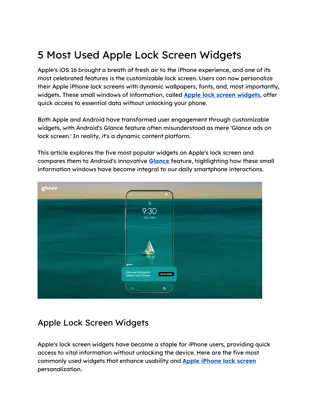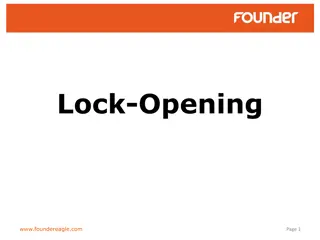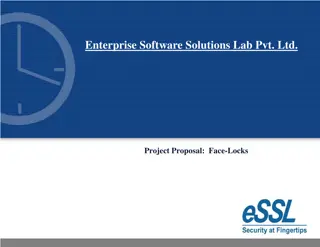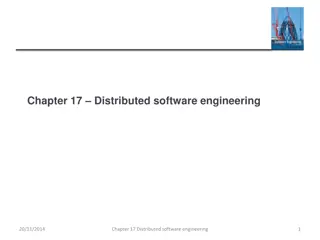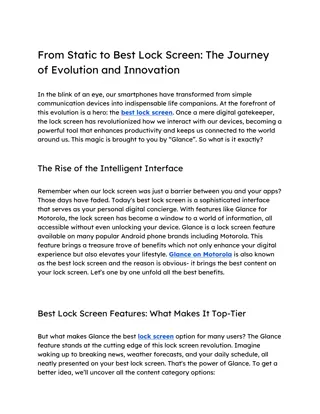The Chubby Lock Service for Distributed Systems
The Chubby Lock Service, based on the research by Mike Burrows from Google, provides a mechanism for synchronizing activities in loosely-coupled distributed systems. It allows clients to agree on basic information, such as choosing a leader, with the help of advisory locks and event notifications. The service emphasizes reliability, availability, and easy-to-understand semantics while addressing the challenges of a distributed consensus through protocols like Paxos.
Download Presentation

Please find below an Image/Link to download the presentation.
The content on the website is provided AS IS for your information and personal use only. It may not be sold, licensed, or shared on other websites without obtaining consent from the author. Download presentation by click this link. If you encounter any issues during the download, it is possible that the publisher has removed the file from their server.
E N D
Presentation Transcript
The Chubby Lock Service Based on a paper by Mike Burrows (Google Inc.) Slides and presentation: Shunit Agmon Burrows, Mike. "The Chubby lock service for loosely-coupled distributed systems." Proceedings of the 7th symposium on Operating systems design and implementation. USENIX Association, 2006.
Outline Purpose and requirements Design rational System Architecture and protocols Handling fail-overs Looking Forward: scaling, unexpected uses and lessons learned
Why do we need locks? void incrementRequestCount(){ count = count + 1; } Request Counter: HTTP request 57 58 59 HTTP request counter=58 counter 59 HTTP request counter=58 counter 59
Why do we need locks? void safeIncrementRequestCount() { lock.lock(); try { count=count+1; } finally { lock.unlock(); } } Request Counter: 58 59 60 HTTP request counter=58 counter 59 HTTP request counter=59 counter 60
Purpose Chubby is a File system Simpler than Unix file system With a lock service (Advisory locks) With event notifications Allow clients to synchronize activities and agree on basic information Specifically, choosing a leader.
Requirements Reliability Availability Easy-to-understand semantics Less crucial: Throughput, Capacity
Outline Purpose and requirements Design rational System Architecture and protocols Handling fail-overs Looking Forward: scaling, unexpected uses and lessons learned
The underlying problem: Distributed Consensus Set of processes, each with initial value. Some processes may fail. All processes that didn t fail must agree on a value out of their initial values. Asynchronous setting: messages may be delayed or dropped. Solved by a protocol called Paxos.
Paxos Protocol for Concensus Three roles: proposer, acceptor, learner. Each process can fill any of the roles. Acceptors Did I promise to ignore id=5? No, so promise to ignore any id<5. Proposer PREPARE id=5 PROMISE id=5 Did I promise to ignore id=4? Yes. Got a majority of PROMISEs? A ACCEPT-REQUEST id=5, val=A ACCEPT id=5,val=A Got a majority of ACCEPTs? Concensus is reached! ACCEPT id=5,val=A Learners Proposer PREPARE id=4 PREPARE id=6 PROMISE id=6, accepted 5,A Timeout for id=4 B Id is chosen from a different set for each proposer. Oh, consensus has already been reached on A .
So, why not just implement a Paxos client library? A Developers don t always plan for availability until after the need to scale. Master election/work partition is easy to implement after the fact with locks. The consensus decision needs to be published easy with files and event notifications. File Saved in Chubby Master s Address Developers (at least think they) know about locks, unlike Paxos. Paxos requires a quorum a minimal number of servers to work reliably. A lock service reduces this load from the client system. File is locked there is a primary (A) B
Design Principles A lock service that also serves small files So that chosen primaries can publish themselves Allow thousands of clients to read the files, without a lot of servers Support event notification, to reduce polling Developers will poll anyway, so use cache. Use consistent cache, so developers are not confused. Security - employ access control. Coarse grained synchronization locks are held for hours/days.
Outline Purpose and requirements Design rational System Architecture and protocols Handling fail-overs Looking Forward: scaling, unexpected uses and lessons learned
System Architecture Chubby cell replicas Chubby client lib Client app . . . Remote Procedure Calls (RPCs) master Chubby client lib Client app
Master and Replica Roles in Read Chubby cell Read RPC Chubby client lib Client app Read response master Only the master is involved in the answer.
Master and Replica Roles in Write Chubby cell Write RPC Chubby client lib Client app Write succeeded master
Chubbys File System A typical filename: /ls/cell_name/path_to_file/filename Similar to Unix: directory and file structure. Unlike Unix: Only whole file read/write Can t move files between directories Can serve different folders by different servers No path-dependent permissions (only file-level) No directory modified time No last-access time on files Easier to cache file metadata No symbolic/hard links
Node (File/Folder) Metadata Access Control Lists (ACLs): For reading, for writing, and for ACL modification. Instance number - # files of that name that existed Content generation number (files only) - # times the file was written Lock generation number - # times the node s lock was held ACL generation number - # times the node s ACL was changed Content checksum
Node Handles When opening a node, the client gets a handle, composed of: Handle id prevents from forging a handle So ACL checks are only done at opening time Sequence number (which master created this handle?) Mode information read/write (for master recovery). The handle supports various operations. Close, Get/Set Contents/Stats, Get/Set/Check Sequencer The client can perform the operations synchronously (wait for completion) or asynchronously (provide a callback).
Files as Locks Each file handle can be used as a readers-writer lock Either many readers (shared mode), or a single writer (exclusive mode). Locks are advisory, not mandatory. Why? The use-case is protecting other services. Mandatory locks mean significant changes to other services. Allow debugging/maintenance while the client services are up. Mandatory locks are not a common practice among Google s developers, and they don t add a lot of protection from bugs/malicious code.
Asynchronous Locks are Hard Lock service Lock held by Alice time Lock held by Bob Lock lease expired lock ok Alice fails and recovers lock ok Write data Write data ok Storage
Solution: Sequencers Lock service Lock held by Alice time Lock held by Bob Lock lease expired lock Ok, Seq #33 Alice fails and recovers lock Ok, Seq #34 Write, Seq #33 Rejected: Invalid Sequencer! Write, Seq #34 Ok
Solution: Sequencers Lock holder requests a sequencer Sequencer - a string, representing the lock name, mode (exclusive/shared), and generation number. To perform a lock-protected action on a server, the client must provide the sequencer. The server verifies the sequencer is valid. What about services without sequencer support? Use lock delay for backwards compatibility.
Events Clients can subscribe to events when creating a handle. Event types: File contents modified Child node added/removed/modified Chubby master fail-over A handle (and lock) became invalid Unused: Lock acquired Conflicting lock request
Client Side Caching Clients keep a cache of file data, node meta-data, and open handles. The cache is consistent, write-through, and kept in-memory. Bob holds a handle to file1 Open(file1) Handle to file1 Write file1 master invalidate file1 Write succeeded Ack (invalidated) Alice s cache file1 Piggybacking on KeepAlives After all clients ack d or expired: Performs write
Sessions and KeepAlives Chubby session between a client and a cell is maintained by KeepAlives. Client s handles, locks, cached data are valid as long as the session is valid. The master promises not to close the session during the session lease timeout. The master can extend the lease on Session creation Master fail-over KeepAlive from client The master never moves up the timeout.
KeepAlive Protocol Application KeepAlive RPC Master waits until the session is really ending New timeout + event notifications + cache invalidations KeepAlive RPC + ack master Chubby library
Outline Purpose and requirements Design rational System Architecture and protocols Handling fail-overs Looking Forward: scaling, unexpected uses and lessons learned
Master Fail-over Old Master Dies OLD MASTER New Master Elected NEW MASTER Session lease M2 Session lease M3 Session lease M1 Success Success Rejected: wrong master epoch number! Epoch is 58 Lease C3 Lease C1 Lease C2 Grace period CLIENT
Backups The master s database is written every few hours to a GFS server in another building. Why another building? Increase resilience Avoid circular dependencies between GFS and Chubby. (GFS cell in the same building might use Chubby for master election). Backups are used for Disaster recovery Initializing the DB of a new replica without burdening replicas in service
Mirroring Mirroring a collection of files between cells. It s fast (world wide changes in < 1 second) thanks to Small files Immediate notification on file changes Checksums are used to discover changes done during lack of connectivity. A special global cell has a path replicated to all cells. Its 5 replicas are around the world to increase accessibility from everywhere. Usage: Configuration and monitoring files, pointers to large databases, etc.
Outline Purpose and requirements Design rational System Architecture and protocols Handling fail-overs Looking Forward: scaling, unexpected uses and lessons learned
Scaling The bottleneck is communication with client processes. There are a lot more processes than machines. Request processing optimizations don t really help. Instead: reduce the number of requests per cell. Increase the number of cells (1 per data center) Increase lease times (less KeepAlives) Client cache: file data and metadata, open handles, file absence Protocol conversion servers (like DNS, more on this soon) Proxies trusted processes handling KeepAlives and Read requests Partitioning of the namespace among servers in a cell Interesting point: How far should the scaling go?
Unexpected Use: Name Service Domain Name Service (DNS) a server that maps from addresses (like goto.google.com) to IPs. DNS cache is based on a fixed Time to Live (TTL) after that, the data is erased. Large TTL can t replace failed services quickly. Small TTL heavy load on the DNS servers. Chubby s cache is based on invalidations, not on TTL Which makes it very suitable to be used as a name service Plus, event notifications help with name modifications, so no polling needed.
Snapshot of a Chubby Cell Stored File Sizes Stored File Types RPC types 0.07% 0.40% 3.20% 0.00% 0.20% 3% 11% 1% 46% 2% 27% 90% 1% naming-related mirrored ACLs/configs GFS/BigTable Metadata ephemeral GetStat CreateSession SetContents Open GetContentAndStat Acquire 0-1k bytes 1k-10k bytes >10k bytes Not included: 93% KeepAlive
Lessons Learned from Real Usage Caching additional things: absence of files (deals with infinite retry loops when a file is not there) open file handles (deals with polling a file by opening and closing it immediately) No quota for large files. But some teams did store large files, and migrating them was hard. Developers are over-optimistic about availability. Solutions: reviews, libraries that abstract away the failures, and post-mortems of outages No need for fine-grained locking. To optimize applications, developers reduce communication, which often means coarse-grained locking. These are just a few.
Impact Widely Used Within Google GFS uses chubby to choose the master server BigTable uses chubby to: Elect a Master Allow the master to discover the servers it controls Allow the clients to find the master Before Chubby, master election required a different solution for each specific problem. Solutions included work duplication, or a human involved.
Summary Chubby is a distributed lock service for coarse-grained synchronization. Its design is based on distributed consensus, replicas for fault tolerance, and consistent client caching. The design is very user (developer) oriented: it has simple semantics and a familiar file system interface. Used widely around Google for its original purpose: primary election, But also as Google s primary name service And as a repository for files requiring high availability: configs, ACLs, etc.
Thank you! Any questions?

 undefined
undefined



